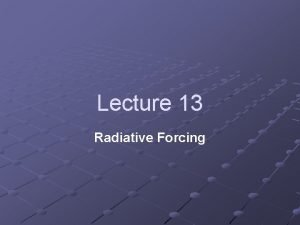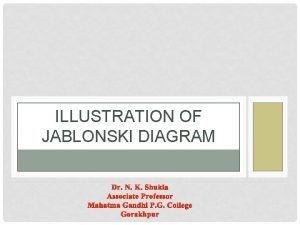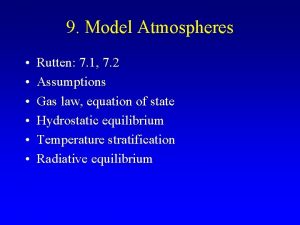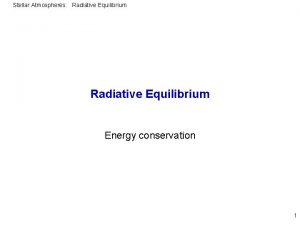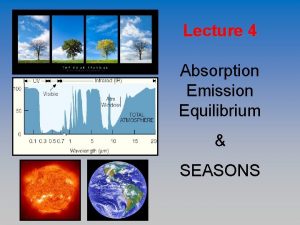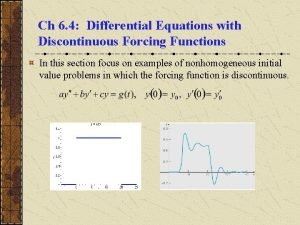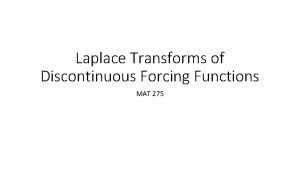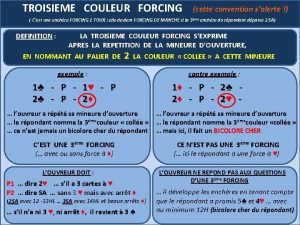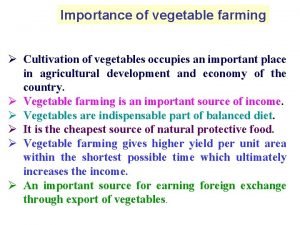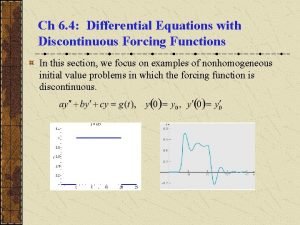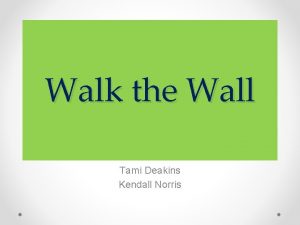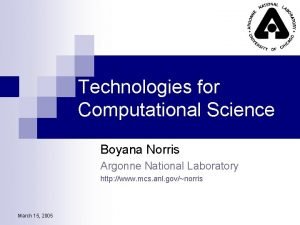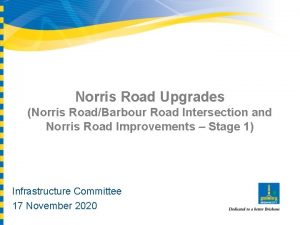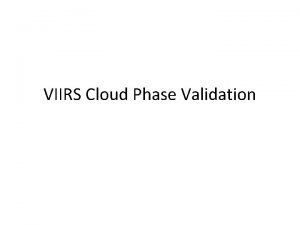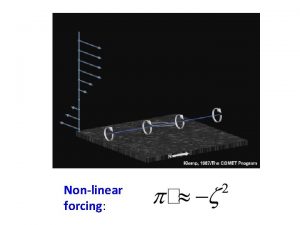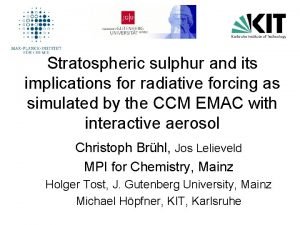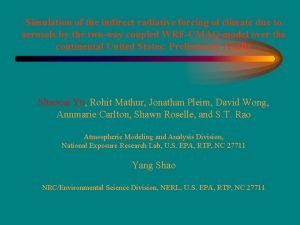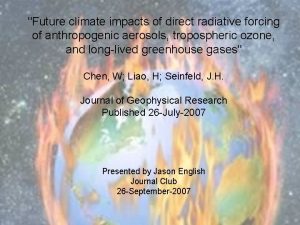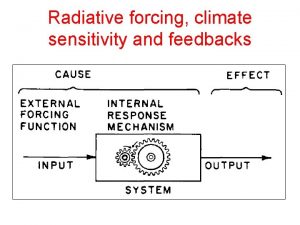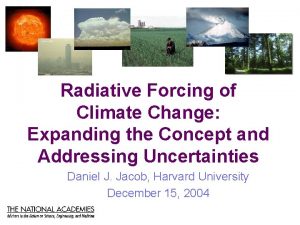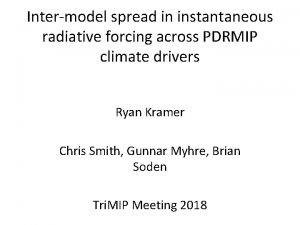MERRA2 Cloud Radiative Forcing Validation Peter Norris MERRA2














- Slides: 14

MERRA-2 Cloud Radiative Forcing Validation Peter Norris MERRA-2 Rollout, NASA/GSFC, June 4, 2015

Introduction • Compare MERRA-2 TOA cloud radiative forcing against CERES EBAF and MERRA. • All results use monthly means, aggregated into 14 year averages, for the period Mar 2000 – Feb 2014. (CERES EBAF available March 2000 onwards). • We look at DJF, JJA, and ANN averages.

TOA Shortwave Cloud Forcing SCF < 0. Clouds cool in solar by reflection Annual Average SCF relative to EBAF (1) MERRA-1 & -2 are both realistic, showing tropical convection, high-latitude stratus, and subtropical subsidence zones (cloud minima); (2) MERRA-2 does better than MERRA over continents, in subsidence zones and in ITCZ; (3) MERRA-2 has excessive Western Pacific & Southern Ocean cloud cooling (albedo).

TOA Shortwave Cloud Forcing Annual Average (zonal) (1) Both MERRA and MERRA-2 are quite realistic, showing tropical convection, Southern Ocean stratus, and subtropical subsidence zones (cloud minima); (2) MERRA-2 does better over continents and in subsidence zones; (3) MERRA-2 has excessive Tropical and Southern Ocean cloudiness.

LCF > 0. Clouds warm in LW by thermal trapping TOA Longwave Cloud Forcing Annual Average LCF relative to EBAF (1) Both MERRA and -2 are very realistic, showing tropical convection, mid-/high-latitude cloud, and subtropical subsidence zones (cloud minima); (2) MERRA-2 does better over continents and in subsidence zones / ITCZ; (3) MERRA-2 has excessive Western Pacific convection.

TOA Longwave Cloud Forcing Annual Average (zonal) (1) Both MERRA and MERRA-2 are very realistic, showing tropical convection, mid-/high-latitude clouds, and subtropical subsidence zones (cloud minima); (2) MERRA-2 does better in southern mid-latitudes and in subsidence zones; (3) MERRA-2 has excessive Tropical cloudiness.

Widespread negative shows net cooling due to clouds TOA Net Cloud Forcing Annual Average NCF relative to EBAF (1) Both MERRA & MERRA-2 show general net negative cloud forcing, especially in stratus regions; (2) MERRA-2 does better over Eurasia and North America; (3) MERRA-2 has excessive Western Pacific and Southern Ocean cloud cooling.

TOA Net Cloud Forcing Annual Average (zonal) (1) Both MERRA and MERRA-2 are realistic; (2) MERRA-2 does better in northern mid-latitudes; (3) MERRA -2 has excessive Tropical and Southern Ocean cloud cooling.

Normalized-SCF vs. LCF joint probability density plots --- How to Read • • These are contour plots of the probability density in normalized-SCF vs. LCF space. X-axis is –SCF/ISR, basically the cloud solar albedo. Y-axis is LCF, the longwave cloud forcing. Larger values represent greater thermal trapping by clouds. For thick clouds it is a rough proxy for cloud height. Purple|Orange|Olive contours contain 10|50|90% of the total probability with the highest probability densities. All densities outside each contours are smaller than those inside. Full 14 yr accumulation for TROPICS • • Each sample is a monthly average. Dilution by cloud fraction/occurrence will move a cloudtype linearly towards origin. Filled contours show CERES EBAF as an observational reference. Thick | Thin lines show MERRA-2 | MERRA.

TROPICS Convective branch Stratiform branch q Stratiform branch: MERRA-2 looks very good (cf. MERRA a bit too bright). q Convective branch: MERRA-2 looks to have a bright bias that cannot be explained by linear dilution.

Mid-latitudes: q Northern --- looks very good, MERRA-2 a little better than MERRA q Southern --- MERRA-2 has a bit of a bright bias.

High-latitudes: q Northern --- looks good but most common 10% is diluted. q Southern --- MERRA-2 has a strong bright bias, worse than MERRA.

Seasonal Variation in Tropics MERRA-2 bright bias is more obvious in boreal summer, including a distinct increase in high-cloud probability.

MERRA-2 Cloud Forcing Summary • The good: – Better overall global cloud forcing pattern. – In particular, tropical ITCZ, subtropical cloud minima, and transition to mid/high-latitude cloud have a more realistic pattern. – Continental cloud is also improved. • The not so good: – Tropical cloud is too bright. – Southern Ocean cloud is too bright. • Have just started looking at surface CRF.
 Radiative forcing definition
Radiative forcing definition Peter norris ysu
Peter norris ysu Draw jablonski diagram
Draw jablonski diagram Radiative equilibrium temperature
Radiative equilibrium temperature Radiative equilibrium temperature
Radiative equilibrium temperature Radiative equilibrium temperature
Radiative equilibrium temperature Differential equations with discontinuous forcing functions
Differential equations with discontinuous forcing functions Transforms of discontinuous functions
Transforms of discontinuous functions Salerte
Salerte Chapter 17 hairstyling answers
Chapter 17 hairstyling answers Importance of vegetable cultivation
Importance of vegetable cultivation Differential equations with discontinuous forcing functions
Differential equations with discontinuous forcing functions Kendall norris
Kendall norris Norris krueger
Norris krueger Boyana norris
Boyana norris
